History of Boca Juniors
Club Atlético Boca Juniors (Spanish pronunciation: [kluβ aˈðletiko ˈβoka ˈʝunjoɾs]) is an Argentine sports club based in the La Boca neighbourhood of Buenos Aires. Although many activities are hosted by the club, Boca Juniors is mostly known for its professional football team, which since it was promoted in 1913, has always played in the Argentine Primera División.[1]
Boca Juniors is the most successful team of Argentina, having won 69 official titles to date.[2][3] Domestic titles won by Boca Juniors include 34 Primera División championships,[4] and 13 National cups.
Internationally, the Boca Juniors have won a total of 22 international titles,[5][6] with 18 recognized by FIFA[7][8][9] third in the world for number of international titles won, together with A.C. Milan, holding eighteen titles each, and behind Real Madrid C.F. with twenty-two international titles and Al Ahly SC with twenty international titles.[10][11] Boca Juniors is also known to be the most popular football club in Argentina, due to its fanbase being composed of approximately 46% of the total population of the country.
Italian immigration to Argentina
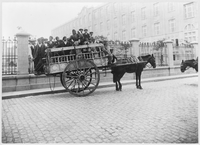
By 1905, Buenos Aires was a city of only 900,000 inhabitants. A significant part of them were Italian immigrants, that had arrived en masse from 1870 to 1920 with a peak between 1900 and 1915. The majority of them established in the Buenos Aires Province, working in a large range of occupations such as agriculture, craft, commerce, among others.[12]
By 1914 the 50% of the immigrants come to Argentina were Italian.[13]
Italian immigrants living in La Boca tried to keep their customs and social practices. The cantinas" were the places where they used to meet and dance the typical Italian rhythms. The dishes were also brought from their country of origin, such as pizza and pasta.[14]
Italian influence is still visible in Argentina, with Lunfardo, the jargon enshrined in tango lyrics, laden with Italianisms, often also found in the mainstream colloquial dialect (Rioplatense Spanish). Common dishes with Italian names and origins (milanesa, fainá, polenta, pascualina) were adopted by Argentina and nowadays they are recognizable dishes of the local gastronomy.
Foundation
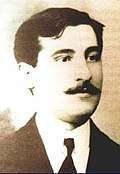
On 3 April 1905, a group of Italian and Greek boys (more specifically from Genoa, Chios and Samos) met in order to find a club. The house where the meeting was arranged was Esteban Baglietto's and the other people who attended were Alfredo Scarpatti, Santiago Sana and brothers Juan and Teodoro Farenga.[15][16]
Baglietto, Sana and Scarpatti had received football lessons by Patrick "Paddy" McCarthy[17][18] an Irish footballer and boxer who came to Argentina in 1900 and taught football techniques to immigrants' children, as an appointed member of the sports municipal committee in Buenos Aires.[19][lower-alpha 1]
After some hours of discussions Baglietto's father threw the boys out of the house and they had to continue with the project in the Plaza Solís, which is recognized today as the place where Boca Juniors was finally founded.[15][21][22]
Other important founders members include Arturo Penney, Marcelino Vergara, Luis Cerezo, Adolfo Taggio, Giovanelli, Donato Abbatángelo, Bertolini.[23] The use of English language in football team names was commonplace, as British railway workers had originally introduced association football into Argentina.[24]
Early years
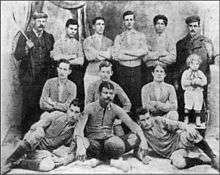
Boca Juniors had several jersey models before adopting its definitive blue and gold design. Some versions state that the first jersey was pink and was worn only for the first two games, although there are no any solid evidence that can prove this.[25] On the other side, founders and first members interviewed claimed that Boca Juniors' first jersey was white with thin black stripes. This model had been made by Juan Farenga's sister. The successive jerseys worn by the team were light blue, being soon replaced by a white with thin blue stripes model, all of them in 1905.[26]
The first match ever played by the club was on April 21, 1905, when the team faced Club Mariano Moreno wearing the white and black striped uniform. The match was played at Dársena Sur and Boca won by 4–0 with goals scored by Juan Farenga (2), José Farenga and Santiago Sana.[27][28] The line-up was: Esteban Baglietto (founder and president); José Farenga (founder and treasurer), Santiago Sana, Vicente Oñate, Guillermo Tyler, Luis De Harenne, Alfredo Scarpatti (secretary), Pedro Moltedo (captain), Amadeo Gelsi (vice-president), Alberto Tallent and Juan Farenga (founder).
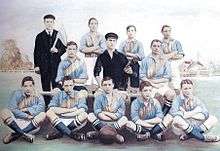
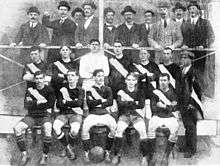
After many friendly matches played, Boca started to participate in minor leagues. In 1905 registered to Villa Lobos League, in 1906 to Liga Central where the team won its first trophy, the "Copa Reformista". In 1907 the club took part of Liga Albión (also winning the tournament). The first international match played by Boca was against Uruguayan team Universal from Montevideo, on December 8, 1907. Boca was defeated 1–0.[29]
In 1907 Boca left the white and blue jersey after losing a match to other team from Almagro district that had a similar uniform. Both teams played a match in order to define which would be wear the colors from then on. As Boca Juniors lost the match, the club had to choose other colors for its uniform. As a port worker himself, former club's president Juan Brichetto suggested to adopt the colors of the flag of the first ship he allowed to cross on the following morning. As the first ship that crossed the bridge was Swedish, Boca Juniors adopted the blue and yellow (gold) as institutional colors.[30] It is believed that it was the 4146-ton freighter "Drottning Sophia", a Swedish vessel sailing from Copenhagen, although other historians say that the Drottning Sophia did not arrived to Buenos Aires in 1907 but in 1905. The ship that gave it colors to Boca Juniors would have probably been the Oskar II of Nordstjernan/Johnson Line, arriving to the port on February 5, 1907.[31]
The first design inspired on the Swedish flag was blue with a diagonal gold sash, used by Boca Juniors until 1913 when it was replaced by a horizontal sash.[32] This design has remained up to present days, with minor changes.
Boca Juniors' first stadium was located in the Isla Demarchi. Juan Brichetto was one of the many fans who donated money to finish the construction. In 1908 Boca Juniors affiliated to the Argentine Football Association to play at the "Segunda de Ascenso" division. Boca Juniors' debut in official tournaments was on May 3, 1908, when the squad defeated Belgrano A.C. II by 3–1 in the stadium of Virrey del Pino and Superí of Belgrano neighborhood. Boca Juniors line-up for that historic match was: Juan de los Santos; Marcelino Vergara, Luis Cerezo; Guillermo Ryan, Alberto Penney, Juan Priano; Arturo Penney, Manuel Eloiso, Rafael Pratt, Pedro Moltedo, José María Farenga. Goals were scored by Pratt (2) and Eloiso. The squad finished in first place (among eight teams) and qualified for the next stage, the semifinals, which Boca played Racing Club, losing 1–0 and being eliminated.[33]
In 1908 Boca Juniors also played the Copa Bullrich and was eliminated after being defeated by Atlanta by 5–0.
In 1910 Boca Juniors played the semifinals against Racing Club and lost by 2–1, also losing not only the match but the promotion to Argentine Primera División. The team roster was formed by Bellocq, Cerezo, Garibaldi, Piralini, Vergara, Bonatti, Spinelli, Arturo Penney, Pastor, Taggino, Giovanelli and Moltedo. The following year, Boca is eliminated in the first round, despite having the same squad as in 1910.
The 1911 team roster was: Ramón Lamique, Miguel Valentini, Emilio Bonatti, Luis Cerezo, Agustín Angoti, Máximo Pierallini, Juan Garibaldi, Lorenzo Etchart, Amílcar Spinelli, Francisco Taggino and Anapodito García.[34]
The coming to Primera División and "Superclásico"
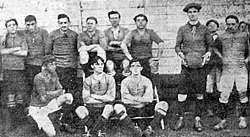
In 1913 Boca obtained the promotion to Primera División that the team had wanted for many years. This was possible when the Asociación Argentina de Fútbol decided to increase the number of teams in the league from 6 to 15.[35] The other teams that went to Primera were Ferro Carril Oeste, Platense, Banfield, Olivos, Comercio, Ferro Carril Sud and Riachuelo.[36]
Boca Juniors finished 5th. at its first season in Primera División, playing a total of 14 matches. The team won 8, lost 4 and drew 2, scoring 29 goals and conceding 16.[37] The next season Boca Juniors finished 3rd. of 13 teams.[38] The 1915 championship the team decreased its performance dramatically, finishing 14th. of 25, also suffering thrashing defeats at the hands of Racing Club (0–6) and San Isidro,[39] the two best teams of the tournament. The defeat to San Isidro remains as the worst defeat ever in official matches.[40]
The first official match between Boca Juniors and arch-rival River Plate, known as Superclásico, was played in the 1913 Primera División championship at Racing Club stadium, being won by River Plate by 2–1.[41] Boca had previously played against River in other unofficial matches, but the exact dates are still under dispute . The most extended version affirms that the first Superclásico ever was played on August 2, 1908, with Boca Juniors being the winner by 2–1, although there are no documents that support the information.[42][43] Other version state that the first recorded match was played in 1912.[44]
First titles and success
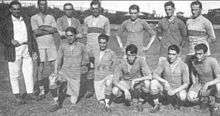
On 20 January 1920, Boca Juniors reached its first championship (which belonged to the 1919 season)[45] after defeating Sportivo Almagro by 4–0. The match was played in Boca stadium, located in Ministro Brin and Senquel streets. Boca Juniors line-up was: Tesoriere; Cortella, Ortega, López, Busso, Elli; Calomino, Bozzo, Garasini, Martín, Miranda. Miranda and Martín were the scorers of the match (2 goals each). The team finished a record of 7 games won over 7 played.[34]
That same year Boca won three titles else, national competitions Copa de Competencia Jockey Club, Copa Dr. Carlos Ibarguren (both vs. the same rival and score: Rosario Central by 1–0) and the last edition of international Tie Cup (defeating Uruguayan team Nacional by 1–0 at Sportivo Barracas field).
The line-up vs. Rosario Central on 8 February 1920 (Copa Ibarguren final) was: Tesoriere; Cortella, Ortega; A. López, Mario Busso, A. Elli; Calomino, Bosso, Garasini, Martín, Miranda. 1919 is the most successful season in club's history, having won 4 titles that year.
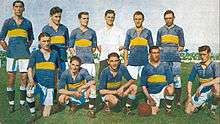
Boca Juniors achieved its second league championship the following year (corresponding to the 1920 season but played in 1921), after a victory of 2–0 against Banfield. Boca played a total of 24 games with 20 won and only 1 lost. In 1923 Boca won its third Primera División title, in a championship where 4 matches had to be played to decide which team (Boca or Huracán) would be the champion, so Boca won the first game but was defeated in the 2nd leg; the 3rd match finished in a tie therefore a 4th game had to be played (at Sportivo Barracas stadium, on 27 April 1924), finally won by Boca 2–0 thus winning the title. Both goals were scored by Garasini. The line-up was: Tesoriere; Bidoglio, Muttis; Médici, Busso, Elli; Calomino, Cerrotti, Garasini, Pozzo, Pertini.
In 1923 Boca also won its second Copa Ibarguren after defeating Rosario Central (the same team that Boca had beaten in 1919) by 1–0 at Sportivo Barracas stadium. The line-up was: Tesoriere; Bidoglio, Muttis; Médici, Coverto, Elli; Calomino, Cerrotti, Tarasconi, Pozzo, Pertini.
Boca was the unbeaten champion of the 1924 season, winning 18 matches out of 19. The team finished with a total of 67 goals scored (an average of 3.52 per game) and only conceded 8.[46] That same year Boca Juniors won its third Copa Dr. Ibarguren after thrashing Rosario Central by 5–1 in Chacarita Juniors stadium.
European tour: "Champion of Honour"
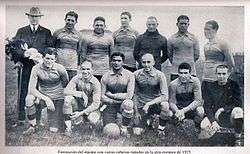
In 1925 Boca made its first trip to Europe to play at Spain, Germany and France. The squad played a total of 19 games, winning 15 of them. Some of the rivals defeated were Real Madrid, Celta de Vigo and Deportivo La Coruña. On 28 June 1926, in a meeting held at the Association Argentina de Football, Boca Juniors was declared "Campeón de Honor" (Champion of Honour) of 1925 season, and each member of the team received a commemorative medal. The players were: Tesoriere, Bidoglio, Muttis, Tarasconi, Busso, Elli, Médici, Garasini, Antraygues, Cerroti, Pertini and Posso.[47]
After the successful tour on Europe, Boca Juniors returned to the local competitions, winning its 5th. Primera División championship in 1926, having finished unbeaten (same as 1924 season) after 17 games played. Boca Juniors and Independiente were to play-off for the unified title following the unification of the two leagues (Asociación Argentina de Football and Asociación Amateurs de Football), but after their match (played on 20 February 1927) was halted due to a spectator invasion, and a replay on 3 March 1927, finished 0–0, no further match was played due to the start of the new season.[48] Boca not only won the league championship but another edition of the Copa de Competencia Jockey Club, defeating Argentinos Juniors in the second match after the first game had finished drawn.
In 1926 Boca Juniors won another national cup, the Copa Estímulo (played while the Argentina national football team played at the South American championship) defeating Sportivo Balcarce by 3–0 at the final.
Boca Juniors finished the 1920s being one of the most successful teams of the decade, winning 4 league titles and 4 national cups during that period.
The 1930s
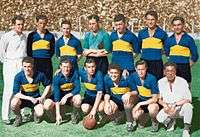
After losing at the hands of San Lorenzo de Almagro the 1929 championship, Boca would win its 6th. title in 1930, when the squad defeated Atlanta by 4–1, just two fixtures before the end of the season. The line-up that attended the match was: Mena, Bidoglio, Muttis; Moreyras, Pedemonte, Arico Suárez; Penella, Kuko, Tarasconi, Cherro, Alberino.
With the introduction of professional football in Argentina, Boca won its 7th. league championship in 1931, defeating its main rival, River Plate by 3–0 in the last fixture. Boca scored 50 points, with a total of 22 victories, 6 draws and 6 losses.[49] The line-up that reached the title in the 34th. fixture was: Fossatti; Muttis; Evaristo, Silenzi, Arico Suárez; Nardini, Tarasconi, Varallo, Cherro, Alberino.
In 1934 Boca won another title, although the team lost 7 matches and conceded 62 goals. Boca crowned in the round 38, when the team defeated Platense by 5–1. The key was in the power of the forwards, who scored 101 goals. Boca Juniors became the first team which scored more than 100 goals in the league. The line-up in the match vs. Platense was: Yustrich; Alves do Río, Bibí, Vernieres, Lazzatti, Arico Suárez; Zatelli, Benítez Cáceres, Varallo, Cherro, Cusatti.
When winning the 1935 season, Boca became the first successive champion of the professional era. The team also scored 100 goals and only conceded 29. Boca Juniors crowned champion in the 33rdh round, after defeating Tigre by 3–0. The line-up for that match was: Yustrich; Domingos, Valussi; Vernieres, Lazzatti, Arico Suárez; Tenorio, Benítez Cáceres, Varallo, Cherro, Garibaldi.
During the decade of the 1930s, some footballers such as Juan Yustrich (nicknamed El Pez Volador -The Flying Fish), Pedro Arico Suárez, Delfín Benítez Cáceres, Domingo Tarasconi, Roberto Cherro and Francisco Varallo were not only big stars but Boca Juniors great idols.
The 1940s
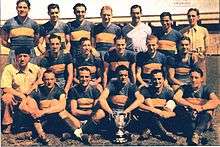
During this period, Boca won three league championships in the 1940s, the same as the previous decade. The first title was obtained in 1940, the same year that La Bombonera was inaugurated. The key match was against Independiente, which Boca won 5–2 therefore crowning champion. The line-up was: Estrada; Ibáñez, Marante; A. López, Lazzatti, Arico Suárez; Sas, Carniglia, Sarlanga, Gandulla, Emeal. Boca won 24 games, drew 7 and lost 3. That same year Boca Juniors won the Copa Ibarguren (the 4th. for the club) after thrashing Rosario Central by 5–1 at Chacarita Juniors stadium. The line-up for that match was: Vacca; Ibáñez, Marante; A. López, Lazzatti, Arico Suárez; Gelpi, Carniglia, Sarlanga, Gandulla, Rossell.[50]
In 1944 Boca would be (for the second time in its history) successive champion, when the squad defeated Racing by 3–0 in the last fixture. The game was played in River Plate stadium (because the Bombonera had been temporarily closed due to hooliganism incidents). Over 19 games Boca Juniors won 19, with 8 draws and 3 losses. The line-up for that match vs. Racing is still remembered as one of the greatest Boca all-time teams: Vacca; Marante, Valussi; Sosa, Lazzatti, Pescia; Boyé, Corcuera, Sarlanga, S. Varela, Sánchez. During that season, Boca also remained unbeated for 26 consecutive matches, which was a record in the professional era until Racing broke this landmark when playing 39 matches without being defeated in 1966.
In 1944 Boca Juniors also won its 5th. Copa Ibarguren, when the squad beat the Tucumán combined by 3–0. The line-up was: Vacca; Melogno, De Zorzi; Sosa, Lazzatti, Pescia; Boyé, Corcuera, Sarlanga, Ricagni, Rodríguez.
Boca Juniors won other National cup in 1946, the Copa de Competencia Británica, when the squad defeated San Lorenzo by 3–1, playing again at River Plate stadium.[51]
On the other hand, Boca was near to being relegated to Segunda División in 1949 but could keep its place in Primera with a large victory over Lanús in the last fixture. It was the first time that Boca finished last in any Primera División season.[52]
The 1950s and the Glorious 1960s
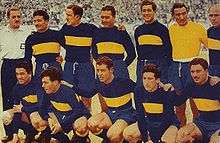
In 1954 Boca won its first title after nine unsuccessful years. The key match was against Huracán, which Boca won 3–1 obtaining the championship. The top scorer was José "Pepino" Borello (19 goals). Another outstanding player was Julio Musimessi, nicknamed "El arquero cantor" ("The singer goalkeeper").
Boca finished 8th in 1959 although the team won the two "Superclásicos" (5–1 and 3–2 after being behind 2–0).
On 9 December 1962, Boca won a legendary match defeating River Plate 1–0, with the highlight being goalkeeper Antonio Roma stopping a penalty shot by Delem when only 6 minutes were left till the end of the match. Boca finally won its first title of the decade in the next fixture with a great victory (4–0) over Estudiantes de La Plata, becoming new champion. During the 1960s, Boca Juniors won 5 championships.
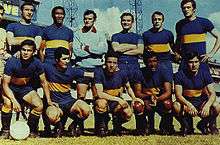
The following title obtained was in 1964, with Antonio Roma not conceding a goal for 742 minutes, and conceding only one goal in 14 matches. In 1965 Boca became successive champions for the 3rd time in the professional era. The key matches were the victory over River Plate (2–1) and Atlanta in the last fixture.
In the 1968 Metropolitano championship during a Superclásico that ended 0–0, seventy-one Boca Juniors supporters died after being squashed against an exit door at River Plate Stadium, which remained closed at the moment of the fans left the stadium. This is still remembered as The Tragedy of the Door No. 12 (La Tragedia de la Puerta 12).
In 1969 an official tournament named Copa Argentina was disputed. Teams included were those playing the Metropolitano and others outside Buenos Aires. Boca Juniors proclaimed champion after defeating Atlanta by goal average (the matches ended 3–1 and 0–1). Boca Juniors played a total of 10 matches, winning 7, with 1 draw and only 1 loss.
During the same year Boca played its last match of the Nacional championship visiting River Plate at the Monumental. The match ended 2–2 (Norberto Madurga scored twice) proclaiming Boca as the new champion. The Xeneizes totalized 29 points, winning 13, with 3 draws and only 1 defeat and were coached by Alfredo Di Stéfano.
1970s: the second "Golden Age"

In 1970 Boca won another title defeating Rosario Central in the final match of the Nacional tournament. In 1976 Juan Carlos Lorenzo arrived at the club. He would become one of the most successful coaches in the history of Boca Juniors, winning 5 official titles within 3 years. First of them was the 1976 Metropolitano, which Boca obtained after defeating Unión de Santa Fe by 2–0, one round before the end of the tournament.
The following tournament (1976 Nacional) Boca played a historic final match against arch-rival River Plate, winning 1–0 through a direct free kick goal scored by Rubén Suñé. Boca Juniors line-up was Gatti; Pernía, Sá, Mouzo, Tarantini; Ribolzi, Suñé, Veglio; Mastrángelo, Taverna, Felman.[53] It was the only final played by both Superclásico teams up to present days.[54]
That championship qualified Boca Juniors to play the 1977 Copa Libertadores, having reached the final match against Cruzeiro. After a victory 1–0 in Buenos Aires and a defeat in Belo Horizonte by the same score, it was necessary to play a third game, hosted in Montevideo where Boca finally obtained the Libertadores for the first time, after a dramatic penalty shoot-out where Hugo Gatti stopped the last shot by Brazilian player Vanderley.
The next title (and the most important of the decade) won by Boca Juniors was the 1977 edition of the Intercontinental Cup vs. German club Borussia Mönchengladbach (played one year later). The first leg played in Buenos Aires ended 2–2 but Boca won the second game 3–0 in Karlsruhe and brought the trophy back to Argentina. The line-up in Germany was Santos; Pernía, Sá, Mouzo, Bordón; Benítez, Suñé, Zanabria; Mastrángelo, Pavón, Salinas.
To close a second part of the decade plenty of achievements, Boca Juniors won its second Copa Libertadores in 1978, after defeating Deportivo Cali (coached by Carlos Bilardo) 4–0 in the Bombonera (the first match played in Colombia had finished 0–0).
1980s: The Maradona revolution and few titles
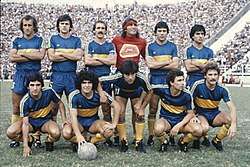
The highlight of the 1980s was the acquisition of the prodigious Diego Maradona, who came to the club along with Miguel Brindisi, Osvaldo Escudero, Marcelo Trobbiani, while former player Silvio Marzolini was appointed as coach. Boca won its first title of the decade, the 1981 Metropolitano championship after a 1–1 draw v. Racing in the round 17th. The Xeneizes totalized 50 points, with 20 wins, 10 draws and 4 losses.[55] Maradona and Brindisi were regarded as the most notable players of the squad.[56]
The following year, Boca lost the young Maradona, who moved to Europe to play for FC Barcelona, owing also to Argentina's political problems. In 1984 Boca was near to a financial collapse, almost going bankrupt. The same year the team suffered their biggest defeat at the hands of FC Barcelona, losing 1–9 in a Joan Gamper Trophy match. After the departure of Marzolini in 1981, Boca Juniors hired several head coaches although the squad could not win any championship until 1989. The list of managers includes Vladislao Cap, Carmelo Faraone, Raúl Rodríguez Seoane, Ernesto Grillo, Miguel Ángel López, Dino Sani, Mario Zanabria, Alfredo Di Stéfano, César Luis Menotti, Roberto Saporiti, Juan C. Lorenzo and José Omar Pastoriza.
In 1985, Antonio Alegre and Carlos Heller were elected president and vice-president, respectively. Under their command, Boca settled 153 lawsuits early in his tenure by mortgaging his business assets for US$250,000, and by lending Boca Juniors US$800,000. These and other measures enabled they to recover the club's finances. Boca also sold the land acquired earlier for US$21 million.
The club's improved finances led to its revival, and Boca emerged victorious in a number of coveted tournaments in subsequent years, being the 1989 Supercopa Sudamericana the last title of the decade. The team, managed by Carlos Aimar, achieve its first international honour since the 1978 Copa Libertadores.
Early 1990s
The number of international titles won increased during the first part of the decade, with Boca Juniors winning the 1990 Recopa Sudamericana, the 1992 Copa Master de Supercopa and the 1993 Copa de Oro (named "Nicolás Leoz"). At domestic level, the squad won the celebrated 1992 Apertura, after eleven years without league titles and managed by Uruguayan Óscar Tabárez, who had arrived to the club in 1991. Some of the most notable players of the late 1980s–early 1990s were Carlos Navarro Montoya (ranked 5th among the footballers who played the most matches with the club), Diego Latorre, Gabriel Batistuta, Juan Simón, Carlos Mac Allister, Carlos Tapia, Blas Giunta, Claudio Marangoni, Sergio Martínez, Alberto Márcico, Roberto Cabañas.
In 1995, entrepreneur Mauricio Macri was elected as president of the club. One of his first actions was to refurbish La Bombonera, demolishing the old boxes to build new ones. The club also built a basketball, venue, Estadio Luis Conde (known as La Bombonerita) with a capacity of 2,000 spectators, inaugurated in 1996. Macri also created an investment fund for the purchase of football players.[57] Macri also hired Jorge Griffa to manage the youth divisions of the club with the purpose of promoting new talents from Boca Juniors instead buying players from other clubs.
The first manager under Macri's presidency was former Argentina national team coach, Carlos Bilardo. His tenure lasted only one year, with no titles won despite the large number of players acquired, including Diego Maradona –who had returned to the club[58]– Claudio Caniggia, Juan Verón, Kily González, Fernando Gamboa and Néstor Fabbri.[59] Bilardo resigned after Boca Juniors finished 10th. in the 1996–97 season.[60] Bilardo's successor was Héctor Veira, but he could not win any title with a team that had its best performance in the 1997 Apertura, finishing runner-up.
The Bianchi era: another Golden Age
Former Vélez Sársfield coach Carlos Bianchi arrived at the club in 1998 and under his command, the squad would achieve multiple local and international titles, breaking the record obtained with Juan Carlos Lorenzo in the 1970s. With Carlos Bianchi as coach, Boca won 9 titles.
The first title obtained was the 1998 Apertura, which Boca won being undefeated for the first time. Martín Palermo was the top scorer with 20 goals in 19 matches played. Boca later won a new championship in the 1999 Clausura becoming successive champions. The team remained undefeated in 40 matches, breaking the record of 39 matches achieved by Racing Club in the 1960s. This mark is still a record in the professional era of Argentine football.
The year 2000 was the most successful for Boca Juniors. The team won the Copa Libertadores after 22 years without winning that trophy, defeating Palmeiras in the finals by penalty-shots after two matches ended in a draw (2–2 and 0–0). Goalkeeper Oscar Córdoba was the most notable player of the final disputed in São Paulo. As the new South America champion, Boca went to Tokyo to play the 2000 Intercontinental Cup against Real Madrid, defeating the Merengue team 2–1 (goals by Palermo). The same year Boca won another local title, the Torneo Apertura, totaling 3 titles in 2000.
In 2001 Boca were Copa Libertadores champion again, defeating Cruz Azul in a penalty-shootout. Boca won 1–0 the first final match in Mexico and lost the second game in La Bombonera by the same score. Oscar Córdoba was the most notable player again.
Bianchi left the club in 2002 due to a conflict with the chairman Mauricio Macri, so Oscar Tabárez was chosen as his replacement beginning his second run as team's coach. Nevertheless, Bianchi would return the following year to take care of the team again. In 2003, Boca obtained a new title winning the Copa Libertadores for the 3rd time in 4 years. The most notable player of that tournament was Carlos Tevez while Marcelo Delgado was the top scorer with 9 goals. In the finals played against Santos FC, Boca won 2–0 in Buenos Aires and 3–1 in São Paulo. Boca Juniors completed another successful year winning the 2003 Intercontinental Cup against AC Milan by penalty-shot after a 1–1 draw. Matías Donnet, who tied the game in the 29th minute, was named the Man of the Match.
Boca reached another Copa Libertadores final in 2004, but lost to Once Caldas from Manizales, Colombia in PK's. Once the Cup was over, Bianchi resigned, finishing one of the most successful periods in the club history.
Basile's multi-champion
After Bianchi's departure from the club, Miguel Brindisi (who had played for the club in the 1980s) was chosen as coach but he soon resigned at the end of the 2004 Apertura, when Boca finished 8th. The successor of Brindisi was Jorge Chino Benítez, another player for Boca in the 1970s and 1980s. Under his coaching Boca won the 2004 Copa Sudamericana defeating Club Bolívar in the finals.
In 2005 (the year of Boca's 100th anniversary) the Xeneize contested another edition of the Copa Libertadores, being eliminated by Chivas de Guadalajara. In that match, Benítez spat at the Chiva's player Adolfo Bautista, causing a melee which resulted in the referee abandoning the match. Due to this act, Benítez was immediately dismissed by the club. After Benítez's dismissal, Boca hired Alfio Basile as its coach.
With Basile as the coach, Boca won the Recopa Sudamericana (2005 edition), defeating Once Caldas, and the 2005 Copa Sudamericana, where the Xeneize won over Pumas from México by penalty-shots after two draws. Roberto Abbondanzieri was the MVP, stopping two shots and converting the decisive penalty kick. Boca would win two titles more: the 2005 Apertura and 2006 Clausura becoming successive champion of Argentine football. The squad also obtained the 2006 Recopa Sudamericana over São Paulo.
After the elimination of the Argentina national football team in the 2006 World Cup, Basile was called by the National Association to take over and left the club under a successful run. Under the coaching of Basile, Boca Juniors won five titles within two years (2005–06).
More international success
Ricardo Lavolpe was chosen to be the coach succeeding Basile. In the 2006 Apertura the team made a good campaign but at the end of the season finished with the same number of points as Estudiantes de La Plata, so both teams had to play a match in order to proclaim a new champion. Estudiantes defeated Boca 2–1 in Vélez Sársfield stadium and Lavolpe resigned as the coach.
The next coach was Miguel Ángel Russo and Juan Román Riquelme returned to the club. Boca Juniors won the 2007 Copa Libertadores defeating Brazilian team Gremio in the finals (3–0 in Buenos Aires and 2–0 in Porto Alegre). Riquelme (who scored 8 goals) was considered to be the best player of the tournament by journalists and fans. As the South American champion, Boca went to Tokyo to dispute the FIFA Club World Cup but was defeated by Italian AC Milan by 4–2.
Carlos Ischia was appointed as coach after Russo's departure. Under his coaching the club won the 2008 Recopa Sudamericana (against Arsenal de Sarandí). On the other hand, Boca was eliminated by Fluminense (which would be the runner up) in the 2008 Copa Libertadores semi-finals. At the end of that year Boca obtained a new title, the 2008 Apertura. That season ended with Boca, San Lorenzo and Tigre in equal 1st position so a play-off tournament had to be contested among those 3 teams in order to proclaim a new champion. Boca won that tournament and became new Argentine champion. That same season Boca's arch-rival River Plate finished the last for the first time in its history.
Boca finished 14th (over 19 teams) in the 2009 Clausura and Ischia was dismissed by the club (although the managers said he had resigned)[61][62] and Basile was called to start his second run as coach. Nevertheless, after finishing 11th in the 2009 Apertura, Basile left the club.
2010s: local success continues
For the 2010 Clausura the team was coached firstly by Abel Alves and then by Roberto Pompei,[63] who were working with the youth teams when they were appointed to coach the first division team. Boca finished 16th so the club decided to hire Claudio Borghi[64] (who had won a title coaching Argentinos Juniors the last season) as team's new coach, but he left the club after 14 matches, due to the bad results obtained.[65] Roberto Pompei was designated to be the coach until the end of the Apertura.[66] Boca finished in 12th position.
In January 2011, Boca hired Julio Falcioni who had won a title coaching Banfield in 2009. The team did not have a good campaign in the Clausura, although Boca won the Superclásico (the last played before River was relegated to the second division) finishing 7th. In the last fixture (when Boca played against Gimnasia y Esgrima de La Plata) Martín Palermo, the all-time top scorer, retired.[67]
For the 2011 Apertura, Boca acquired goalkeeper Agustín Orión and veteran centre back Rolando Schiavi, who returned after his tenure at Newell's Old Boys. After three years without any achievements, Boca won its 30th. league title when the squad defeated Banfield by 3–0 on round 17. The line-up was Orion; Roncaglia, Schiavi, Insaurralde, Clemente Rodríguez; Rivero, Somoza, Erviti; Chávez; Mouche, Cvitanich.[68] Boca Juniors completed the tournament remaining unbeaten, with 12 wins and 7 draws. The team also conceded the fewest goals (only 6 in 19 matches disputed) which set a record for short tournaments in Argentina (after Clausura and Apertura championships were established in 1991).[69][70][71] That same season, Boca also won the second edition of the relaunched Copa Argentina, after beating Racing Club at the final. Some changes in the line-up were goalkeeper Ustari, defender Caruzzo and forwards Viatri and Silva.
In 2012, Boca reached the final of Copa Libertadores, five years after having won the 2007 final, but the squad lost to Brazilian Corinthians by 3–1 on aggregate. On the knockout stages, the squad had previously eliminated Unión Española, Fluminense and Universidad de Chile.
In 2013, it was confirmed that Carlos Bianchi, the most successful coach in Boca Juniors' history, would return to take care of the team again. On August 28, 2014, after 74 matches with only 45 percent effectiveness (26 wins and losses), having conceded 88 and scored 79 goals and without any championships, Bianchi was dismissed by the club.[72][73]
After dismissing Bianchi, former player Rodolfo Arruabarrena was hired as manager of the club. With Arruabarrena as coach, Boca Juniors qualified to the semifinals of 2014 Copa Sudamericana but it was defeated by River Plate (0–1 on aggregate). The next year, Boca Juniors was disqualified from the 2015 Copa Libertadores by CONMEBOL following the incidents that occurred during the match against River Plate at La Bombonera. The sentence came after four River Plate players, Leonardo Ponzio, Leonel Vangioni, Ramiro Funes Mori and Matías Kranevitter suffered a "chemical kerititis", an inflammation of the cornea, as a result of the exposure to chemicals during the second leg match against Boca at La Bombonera.[74] Prior to those incidents, Boca Juniors had won all the games at group stage finishing with 18 points and only 2 goals conceded in 6 games played.
After the frustration at Copa Libertadores, Boca would win its 31st league title in 2015 when the team defeated Tigre in the penultimate fixture of the championship with a goal scored by Fabián Monzón.[75] The line-up for that match was Orión; Gino Peruzzi, Tobio, Rolín, Monzón; Pablo Pérez, Cubas, Meli, Lodeiro; Tevez, Calleri. Tevez (who had left Juventus to join Boca Juniors at the beginning of that year) was the keyplayer of the team. Only three days after winning the Primera División title, Boca Juniors won the 2014–15 Copa Argentina after beating Rosario Central by 2–0 in a match played at Estadio Mario Alberto Kempes of Córdoba. The match became controversial due to referee Ceballos disallowed a Rosario Central goal and awarded Boca Juniors a penalty kick after the foul was committed outside the penalty area.[76]
The Barros Schelotto era
On February 29, 2016, Arruabarrena was dismissed as Boca Juniors manager. Under his coaching, the squad won two titles in 75 games, winning 47, drawing 13 and losing 15.[77] On March 1, Guillermo Barros Schelotto was announced as the new manager,[78] being his third time as manager in a professional football team. He returned to the club after his step as player between 1997 and 2007 where he won 16 titles.
Boca Juniors' last achievement to date is the 2016–17 Primera División title, where the team crowned champion before playing the 29th round v. Olimpo in Bahía Blanca. Therefore, Boca Juniors became the most winning club of Argentina with 66 official titles.[79] The line-up v. Olimpo was Rossi; Jara, Tobio, Magallán, Silva; Gago, Barrios, Pablo Pérez; Pavón, Benedetto, Centurión.[80] Benedetto was also the topscorer of the competition with 21 goals.
Notes
- Nevertheless, other sources refer to McCarthy as the only founder of the club and the Italian immigrants as the persons who made it their own.[20]
References
- "Boca Juniors in Argentina Primera Division"
- Ranking de campeones argentinos: así quedó la tabla histórica después del título de Boca, La Nación, 7 Mar 2020
- Boca se adueñó de la Superliga y estiró la distancia con River en la tabla histórica de títulos, Infobae, 7 Mar 2020
- Campeones de Primera División on AFA website (retrieved 7 Nov 2015)
- 38 Campeones de Fútbol Argentino by Diego Estévez – Ediciones Continente – ISBN 9789507543692
- "Boca Juniors, 63 Titulos En Su Historia", 6 Feb 2014
- "Madrid equal Milan and Boca on 18 international titles", Goal.com, 21 Dec 2014
- "Club Clásico – Boca Juniors" on FIFA.com
- "Boca Juniors have joined AC Milan as the club in the world who have won the most international titles", Goal.com, 28 Aug 2008
- Conn, Tom (21 December 2014). "Real Madrid match AC Milan and Boca Juniors with 18 international titles". Inside Spanish Football. Archived from the original on 22 December 2014. Retrieved 22 December 2014.
- "Milan loses the throne. Al Ahly is the most successful club in the world". Football Magazine. 22 February 2014. Retrieved 22 December 2014.
- "Colectividad Italiana" at ONI website
- Immigrants in the Lands of Promise: Italians in Buenos Aires and New York City, 1870 to 1914 by Samuel Baily – Published by Cornell University Press, ISBN 0801488826
- "Historia de Boca Juniors". Archived from the original on 2016-03-03. Retrieved 2014-11-24.
- "Historia de Boca Juniors". Informexeneize.com.ar. Archived from the original on 3 March 2016. Retrieved 5 May 2013.
- "El Club: Historia at Boca Juniors official website". Bocajuniors.com.ar. Archived from the original on 29 January 2013. Retrieved 5 May 2013.
- "The Sporting Dimension to the Relationship Between Ireland and Latin America" by John Kennedy". Irlandeses.org. Retrieved 5 May 2013.
- The complete book of football, edited by Chris Hunt
- "Paddy McCarthy at Society for Irish Latin America Studies". Irlandeses.org. Retrieved 5 May 2013.
- The World's Game: A History of Soccer by William Murray, University of Illinois, 1998, ISBN 978-0252067181
- "BBC Sport article". BBC News. 5 October 2002. Retrieved 5 May 2013.
- "La historia de una pasión inigualable" by Pedro Uzquiza, Clarín, 30 Nov 1998
- "Historia de Boca Juniors". Informexeneize.com. Archived from the original on 3 March 2016. Retrieved 31 January 2013.
- "Boca Juniors club history". Boca Juniors.com. Archived from the original on 26 May 2010. Retrieved 8 June 2010.
- "La camiseta rosa" by Javier Vaca and Sergio Lodise on CECAD Magazine #3, February 2013
- "La camiseta" at Boca Juniors official web Archived 2008-12-29 at the Wayback Machine
- "Y un día Boca salió a la cancha" on El Espectador, 21 Apr 2005 Archived 2013-09-20 at the Wayback Machine
- "Boca te llevo en el alma y en la web" on Clarín, 29 Apr 1998
- "Club Boca Juniors de Argentina – Universidad del CEMA website
- "Club Atlético Boca Juniors" at Barriada.com.ar
- "De otro barco?" at Planeta Boca Juniors website
- "La nueva camiseta de Boca trae polémica" on La Nación, 2005
- El debut oficial de Boca: la génesis de una gran historia by Oscar Barnade, Clarín, 3 May 2017
- "Amateurismo". Informe Xeneize. Archived from the original on 28 October 2016. Retrieved 7 September 2013.
- "RSSSF Argentine divisional movements". Rsssf.com. 6 December 2006. Retrieved 5 May 2013.
- Hace 105 años Boca estaba en la "B" y ascendió con el escritorio (y el apoyo de River) by Abel Escudero Zadrayec, Clarín, 18 Jul 2017
- Argentina 1913 on RSSSF
- Argentina 1914
- Argentina 1915
- "Boca sufrió su segunda peor derrota en el profesionalismo" on Clarín, 13 Apr 2013
- "Superclásicos que hicieron historia", ESPN, 14 Jan 2008
- 320 Superclásicos by Diego Estévez, Published by Ciudad (2007) – ISBN 978-950-754-237-4
- ""El primer superclásico" at Informe Xeneixe". Archived from the original on 2016-03-03. Retrieved 2014-11-24.
- "El superclásico: 300 veces cara a cara" by Oscar Barnade on Clarín, 9 Nov 2003
- 1919 Argentina season and results
- Argentina 1924
- "Amateurismo 1925". Informexeneize.com.ar. Retrieved 5 May 2013.
- "Argentina: List of Champions and Runners-Up – RSSSF". Rsssf.com. Retrieved 5 May 2013.
- "RSSSF List of Argentine champions and runners up". Rsssf.com. Retrieved 5 May 2013.
- Copa Ibarguren 1940 on RSSSF
- Argentina – Torneo Competencia "George VI" – 1946, RSSSF
- "Argentina – Primera División 1949" by Osvaldo Carluccio
- Argentina 1976 by Pablo Ciullini and Osvaldo José Gorgazzi at RSSSF
- Boca y River: La noche inmortal on El Gráfico, December 2011
- Argentina 1981 – Campeonato Metropolitano by Osvaldo Gorgazzi on RSSSF.com
- Boca '81 on El Gráfico
- Boca ya está en la bolsa, Clarín, 23 Sep 1997
- Hace 20 años, Maradona volvía a Boca, La Voz, 7 Oct 2015
- Carlos Bilardo on Imborrable Boca, 17 Dec 2008
- Arruabarrena: "En el 96 Boca trajo 15 jugadores y salió en la mitad", Olé, 14 Feb 2015
- "Aceleraron el despido de Ischia", La Nación, 2009-05-24
- "Ischia blanqueó el despido", La Nación, 2009-05-30
- "Roberto Pompei, el manotazo de ahogado de Ameal", Canchallena.com, 2010-04-09
- "Confirmado: Borghi será el DT de Boca", Perfil.com, 2010-05-19
- "El decepcionante adiós: Borghi cayó preso de su propia inestabilidad", Canchallena.com, 2010-11-17
- "Pompei de interino, y después?", Canchallena.com, 2010-11-17
- "Se retiró Martín Palermo, el 'Titán' del gol", Diario Perfil 2011-06-18
- Boca es otra vez campeón del fútbol argentino, Mundo D, 5 Dec 2011
- "El campeón record", Clarín, 2011-12-12
- "Boca es un campeón record", Diario24, 2011-12-11
- Boca campeón record", Dia a Dia, 2011-12-12
- "Bianchau", Diario Olé, 2014-08-29
- "Bianchi en rojo", Diario Olé, 2014-08-29
- "Conmebol disqualifies Boca from Libertadores", The Buenos Aires Herald, 16 May 2015
- "Boca se desahogó y salió campeón en una Bombonera que desbordó de alegría", Cancha Llena, 1 Nov 2015 (Archived)
- En una final envuelta por las polémicas, Boca venció a Rosario Central y se consagró campeón de la Copa Argentina, La Nación, 4 Nov 2015
- ""Siempre le estaré agradecido a Boca"". Página Oficial Boca Juniors.
- "Promesa cumplida". Diario Olé. Retrieved 1 March 2016. (in Spanish)
- Olimpo-Boca, torneo primera división: el campeón debió conformarse con un empate en Bahía Blanca by Franco Tossi, La Nación, 21 Jun 2017
External links
